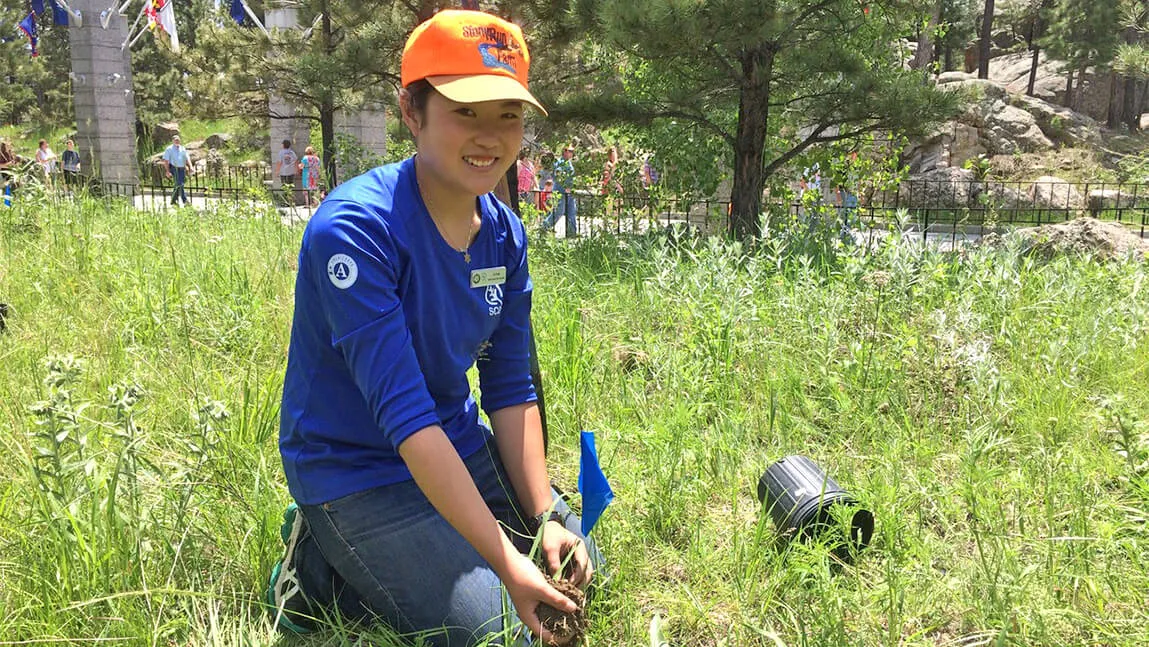The University of Vermont (UVM) Rubenstein School of Environment and Natural Resources appealed to Amie Schiller ’15 for its experiential learning opportunities—from service-learning courses to field labs on the School’s forests and Lake Champlain research vessel. Her training and experiences in the Rubenstein School, followed by several Student Conservation Association internships, served as stepping stones to a career in environmental conservation and stewardship.
Selected as an Aiken Scholar in the School, Amie chose to major in Wildlife and Fisheries Biology because of her love for animals. She soon developed another interest and skill. She acknowledged Rubenstein School faculty and staff who encouraged her to minor in Geospatial Technologies to help make her more competitive in her job search.
“Geospatial training has become a requirement in natural resource fields,” said Amie, who is now a stewardship coordinator with the Minnesota Land Trust. “Through my service-learning experiences and GIS training, I built up a really good working knowledge for solving problems through mapping.”
She first put her geospatial skills into practice her junior year during an internship with the Vermont Department of Forests, Parks and Recreation. Amie worked with state and local partners to research and map the history and value of Vermont’s village greens.
She coordinated more than forty students in Rubenstein School service-learning courses to collect ethnographic, landscape, and architectural data about nine village greens. She pulled together i-Tree data collected by the students to help denote the ecological and economic value of the trees on the greens. Her final 65-page Vermont Village Greens Report compiles student data, displays maps of tree locations, and details ecological, cultural, economic, and historical value of the greens.
“I learned about my own state and helped to showcase the New England tradition of village centers,” said Amie, who is originally from Brattleboro, Vermont. “My service-learning experience combined technical, data, and writing skills with the human dimensions of working with a team and organizing students, all of which helped with my future jobs.”
Amie credited Anna Smiles-Becker, career counselor and internship coordinator in the Rubenstein School, with helping her to find internships, navigate college, and plan for her future.
“Anna is a really awesome mentor; I still check in with her and she continues to provide advice,” said Amie, who served for three years as a student ambassador with the Rubenstein School Stewards program advised by Anna at that time. “She helped me to figure out my direction in life and gain confidence along the way.”
Following her graduation in 2015, Amie went on to three consecutive internships through the Student Conservation Association (SCA) National Park Service Academy. From South Dakota to Vermont to Washington, DC, she put her expertise to use managing invasive species, mapping park infrastructure, and digitizing historic building and landscape surveys.
“My experiences with the SCA gave me the opportunity to travel, connected me with inspiring mentors, and gave me hands-on experience which helped me get to where I am today,” said Amie.
Full-time Conservation Position
Her internships and her geospatial and data experience added up to a full-time, permanent position in 2018 with the Minnesota Land Trust. She helps to manage the nonprofit’s conservation easements on private lands throughout the state—more than 630 properties on a total of more than 70,000 acres.
Amie surveys vegetation, trees, and other property features and takes photos for documentation. She then conducts background research and continues to use her mapping, data, and technical writing skills in updating baseline reports to create long-term pictures of how each property changes over time. All of her work feeds into a complex database of property and landowner information.
“I enjoy working with the Land Trust’s many longtime landowners and volunteers who have a lot of knowledge about the land and are willing to share their stories,” she said.
In 2018, Amie attended a national Land Trust Alliance conference where she and some colleagues observed very few conservation practitioners of color, especially leading workshops. The small founding group created Conservationists of Color. At the 2019 national conference, the group presented their first workshop on how to bring People of Color into the conservation field.
Conservationists of Color has now grown to more than 100 members, and Amie has co-led a second workshop to highlight successful projects and organizations centering BIPOC work and partnerships in conservation.
“It is great to have a group of people similar to yourself to learn from and share experiences in the conservation field,” said Amie.
